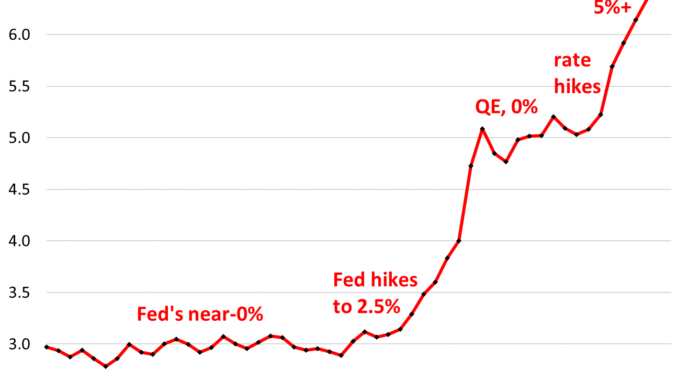
Households’ money market fund & CD balances rise to a record $7.4 trillion; “savings” are far from depleted, they’re bigger than ever.
By Wolf Richter for WOLF STREET.
Americans hate, hate, hate inflation. But they like the higher yields on their cash that came with it, and they put a lot of cash to work by yanking it out of their bank checking accounts and near-0% savings accounts and putting it into much higher yielding money market funds and “brokered CDs” that they bought through their brokerage accounts, which forced banks to compete by raising their own interest rates they paid on deposits to keep deposits from fleeing, and to attract new deposits to replace those that had fled.
And Americans flocked to those CDs too, and they switched back and forth between CDs, money market funds (MMFs), T-bills (Treasury securities of one year or less), and savings accounts, arbitraging rate differences and convenience, thereby keeping banks on their toes. And they continued.
MMF balances held by households jumped to $3.94 trillion at the end of Q2, up from $2.6 trillion during the 0% pandemic era, and up from $1.6 trillion before the rate-hike cycle of 2017-2018, according to data released yesterday afternoon by the Fed as part of its quarterly Z1 Financial Accounts.
These MMF balances include retail MMFs that households buy directly from their broker or bank, and institutional MMFs that households hold indirectly through their employers, trustees, and fiduciaries who buy those funds on behalf of their clients, employees, or owners.
MMFs are mutual funds that invest in relatively safe short-term instruments, such as Treasury bills, repos in the repo market, repos with the Fed – what the Fed calls “Overnight Reverse Repos” (ON RRPs) – high-grade commercial paper, and high-grade asset-backed commercial paper.
Total MMFs held by households and institutions jumped to $6.55 trillion by the end of Q2, according to the Fed’s data yesterday, having doubled since 2018, and having jumped by over 30% since the rate hikes started in 2022.
But somewhat counter-intuitively: When the Fed cut rates in 2019, cash continued to pile into money market funds. It wasn’t until Q3 2020, with yields down to near-0%, that some cash left MMFs, but not much, and balances remained high and essentially flat until yields started rising again, at which point more cash came into the funds. In other words, rate cuts to even 0% didn’t drain the MMFs, but balances stopped rising.
Banks have to compete with MMFs and T-bills.
The nonbank entities that offered higher yields on cash – MMFs and T-bills available through brokers and TreasuryDirect – forced bank to do what they loathe to do in 2022 and 2023: raise the interest rates they pay on deposits.
Banks loathe it because it increases their cost of funding. But if they don’t do it, their deposits leave, which can pose big problems for banks: In March and April 2023, Silicon Valley Bank, Signature Bank, First Republic collapsed and Silvergate Capital was forced to shut down by regulators because their depositors yanked their money out essentially overnight. So banks have to try to hang on to their deposits.
Deposits are loans from customers to the banks and form the backbone of bank funding. Customers yank their cash out to put it into MMFs or T-bills when the bank’s interest rates on CDs or savings accounts aren’t high enough. But deposits are generally “sticky,” so this time too, it was a slow process for bank customers to chase higher yields somewhere else.
But eventually banks had to offer more attractive rates, at first to some customers, namely new customers, and eventually more broadly to existing customers to attract new deposits and hang on to their existing deposits.
For banks, CDs (“time deposits”) provide funding that is more stable – they mature on a fixed date in the future – than savings or checking accounts whose cash can be yanked out anytime via electronic fund transfers.
But rate hikes stopped in July 2023, and amid endless discussion of rate cuts since then, banks have largely reduced the interest rates they’re offering, and CD balances have stopped rising, and for large deposits, have started to dip.
Large Time-Deposits (CDs of $100,000 or more) dipped in July to $2.32 trillion, the second month in a row of declines from the peak in May, according to the Fed’s monthly H.8 data on Assets and Liabilities of Commercial Banks.
In two years since March 2022, when the rate hikes began, large time-deposits surged by nearly $1 trillion, or by 69%.
The Fed’s interest rate repression during the Financial Crisis caused banks to slash the interest rates on CDs to near-0%. The cashflow of savers was sacrificed at the altar of asset-price inflation. And CD balances plunged, as deposits mostly reverted to other types of bank accounts that paid nothing and whose balances continue to swell.
Small Time-Deposits (CDs of less than $100,000) have been roughly unchanged since CD rates stopped rising late last year and in July ticked up a hair to $1.11 trillion, roughly flat with February.
These small CDs reflect what regular folks are doing with their savings. When the Fed gutted their cash flow from savings in 2008, they lost interest in CDs, and the cash reverted to savings and checking accounts, and some wandered off to money market funds and other investments, and CD balances fell by over 70%.
During the rate-hike cycle in the two years through 2018, Americans started buying CDs again. But then the Fed cut rates to near 0% again, starting in 2019, and with their cashflows once again gutted by the Fed, savers lost interest, and by early 2022, just before the new rate hikes, balances of small CDs had collapsed to just $36 billion.
But the move since then has been stunning as banks tried to keep their customers’ cash from fleeing to MMFs and T-bills.
Treasury bills: There are currently $6.11 trillion of T-bills outstanding (they mature in one year or less), and the government is issuing huge amounts of them amid huge demand at T-bill auctions. We don’t know the amounts of cash that households invested in T-bills, either at their broker or directly at TreasuryDirect, but it’s significant.
Total deposits at all commercial banks, including CDs and all other bank accounts, edged up to $17.5 trillion in July. These are deposits by all bank customers: households, businesses, and government entities (except the Federal Government, which has its checking account at the New York Fed and is not included here).
Total deposits at all commercial banks spiked during pandemic-era QE. But when interest rates rose, some of the deposits left the banking system and moved to money market funds and T-bills, and total deposits fell by about $1 trillion through mid-2023. Since then, total deposits have slowly grown:
Take the Survey at https://survey.energynewsbeat.com/






